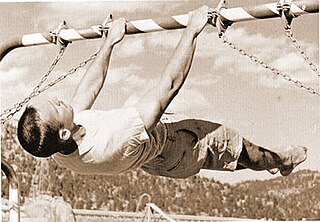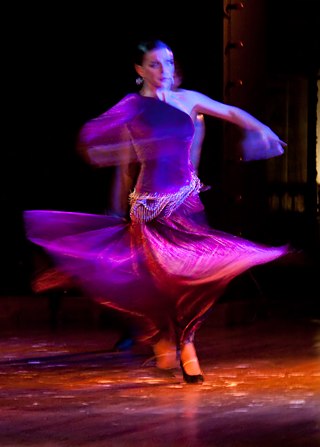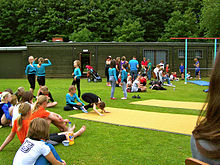
Calisthenics or callisthenics (/ˌkælɪsˈθɛnɪk/) is a form of strength training that utilizes an individual's body weight as resistance to perform multi-joint, compound movements with little or no equipment.

A somersault is an acrobatic exercise in which a person's body rotates 360° around a horizontal axis with the feet passing over the head. A somersault can be performed forwards, backwards or sideways and can be executed in the air or on the ground. When performed on the ground, it is typically called a roll.
Professional wrestling throws are the application of professional wrestling techniques that involve lifting the opponent up and throwing or slamming them down. They are sometimes also called "power" maneuvers, as they are meant to emphasize a wrestler's strength. Many of these moves are used as finishers by various wrestlers, who refer to them by several different names that reflect their gimmick. Moves are listed under general categories whenever possible.

Kneeboarding is an aquatic sport where the participant is towed on a buoyant, convex, and hydrodynamically shaped board at a planing speed, most often behind a motorboat. Kneeboarding on a surf style board with fin(s) is also done in waves at the beach. In the usual configuration of a tow-sport kneeboard, riders kneel on their heels on the board, and secure themselves to the deck with an adjustable Velcro strap over their thighs. Most water ski kneeboards do not have fins to allow for easier surface spins. As in wakeboarding or water skiing, the rider hangs onto a tow-rope. The advantages of kneeboarding versus other tow-sports seems to be an easier learning curve and a sense of being closer to the water when falls occur.

A handstand is the act of supporting the body in a stable, inverted vertical position by balancing on the hands. In a basic handstand, the body is held straight with arms and legs fully extended, with hands spaced approximately shoulder-width apart and the legs together. There are many variations of handstands, all of which require the performer to possess adequate balance and upper body strength.

In professional wrestling, a pin is a move where a wrestler holds an opponent's shoulders to the mat in an attempt to score a fall. A pinfall is a common victory condition, where the attacker pins an opponent and the referee makes a three count before the opponent gets released from the pin.

A cartwheel is a sideways rotary movement of the body. It is performed by bringing the hands to the floor one at a time while the body inverts. The legs travel over the body trunk while one or both hands are on the floor, and then the feet return to the floor one at a time, ending with the athlete standing upright. It is performed in a variety of athletic activities, including performance dance and some types of Indian dance, in gymnastics and cheer, and in the martial arts of capoeira. It is called a cartwheel because the performer's arms and legs move in a fashion similar to the spokes of a turning (cart) wheel. In classical Indian Karana dance, it is called talavilasitam, and in capoeira is called aú. Its first use has been recorded in 1925 by Matthew Douglass, the leader of a popular circus based in Gosforth, Newcastle, who used the trick when dodging flaming spears.

A handspring is an acrobatic move in which a person executes a complete revolution of the body by lunging headfirst from an upright position into an inverted vertical position and then pushing off from the floor with the hands so as to leap back to an upright position. The direction of body rotation in a handspring may be either forward or backward, and either kind may be performed from a stationary standing position or while in motion.

The flare is an acrobatic move in which the performer alternates balancing the torso between either arm while swinging the legs beneath in continuous circles. It is a fundamental b-boying/bgirl power move, and in gymnastics it may be performed on a pommel horse or during the floor exercise. The move is commonly spelled flair in gymnastics and further may be called a "Thomas flair" after its originator, Kurt Thomas.

Yurchenko, also known as round-off entry vaults, are a family of vaults performed in artistic gymnastics in which the gymnast does a round-off onto the springboard and a back handspring onto the horse or vaulting table. The gymnast then performs a salto, which may range in difficulty from a simple single tuck to a triple twist layout. Different variations in the difficulty of the salto lead to higher D-scores. This family of vaults is the most common type of vault in gymnastics and it's named after Natalia Yurchenko, who first performed it in 1982.

Static trapeze, also known as fixed trapeze, is a type of circus apparatus. In contrast to the other forms of trapeze, static trapeze the bars and ropes mainly stay in place.

The front lever is a gymnastic and calisthenic move - a static hold normally performed on the still rings or the pull-up bar. A front lever is performed by lowering from an inverted hang until the body is completely horizontal and straight with the front of the body facing upwards. An accomplished gymnast may also pull directly into the horizontal position from a dead hang. Front levers require a high degree of back and core strength.
This is a general glossary of the terms used in the sport of gymnastics.

An acrobatic flip is a sequence of body movements in which a person leaps into the air and then rotates one or more times while airborne. Acrobatic flips are performed in acro dance, free running, gymnastics, cheerleading, high jumping, tricking, goal celebrations and various other activities. This is in contrast to freestyle BMX flips, in which a person revolves in the air about a bicycle.

In dance and gymnastics, a turn is a rotation of the body about the vertical axis. It is usually a complete rotation of the body, although quarter (90°) and half (180°) turns are possible for some types of turns. Multiple, consecutive turns are typically named according to the number of 360° rotations.
A giant is an artistic gymnastics skill in which a gymnast rotates 360 degrees around an axis while in a fully extended position. It is performed on the uneven bars in women's artistic gymnastics and on the parallel bars, horizontal bar, and rings in men's artistic gymnastics.

The men's rings competition at the 1936 Summer Olympics was held at the Waldbühne on 10 and 11 August. It was the sixth appearance of the event. There were 111 competitors from 14 nations, with each nation sending a team of up to 8 men. The event was won by Alois Hudec of Czechoslovakia, the nation's first victory after winning two silver medals and two bronze medals in 1924 and 1928. Leon Štukelj was the silver medalist in Berlin, the second man to earn two medals in the rings after his 1928 gold. Host Germany took a bronze medal, its first in the rings since 1896, as Matthias Volz finished third.

The men's parallel bars competition at the 1936 Summer Olympics was held at the Waldbühne on 10 and 11 August. It was the sixth appearance of the event. There were 110 competitors from 14 nations, with each nation sending a team of up to 8 men. The event was won by Konrad Frey of Germany, the nation's first victory in the event since 1896. Germany also took the bronze, as Alfred Schwarzmann finished third. Second place and the silver medal went to Michael Reusch of Switzerland. Germany was the first nation to have two gymnasts win the parallel bars.

The men's horizontal bar competition at the 1936 Summer Olympics was held at the Waldbühne on 10 and 11 August. It was the sixth appearance of the event. There were 110 competitors from 14 nations, with each nation sending a team of up to 8 men. The event was won by Aleksanteri Saarvala of Finland, the nation's first victory in the event. Germany took silver and bronze, as Konrad Frey finished second and Alfred Schwarzmann finished third.




















